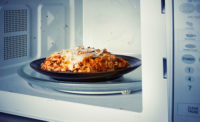Packaging Technology
The microwave’s influence on packaging trends

Editor’s Note: This story originally appeared on Food & Beverage Packaging magazine’s Web site (www.foodandbeveragepackaging.com) earlier this summer. Food & Beverage Packaging is a BNP Media sister publication of The National Provisioner.
As plastics have become more and more common in packaging, concerns have arisen about their ability to compromise the quality and safety of products. Therefore, there has been a marked increase in demand for packaging materials that give even greater protection to their contents, particularly in the food and beverage sector.
A variety of barrier technologies have been commercialized that preserve, protect and optimize product shelf life, reduce the need for preservatives, provide transparency and gloss, and serve as a printing substrate. Without such barrier packaging, perishable goods such as food, beverages and pharmaceuticals would be susceptible to a wide range of deterioration processes. Therefore this type of technology has begun to replace more traditional pack types. In this new bulletin, Smithers Pira (smitherspira.com) examines the various challenges and forecasts in the high barrier packaging films industry.
Replacement of rigid pack formats
 Consumer and technology trends have contributed to a gradual decline of rigid pack formats in the face of flexible packaging and barrier films during the last decade or so. Busier consumer lifestyles and the consequent demand for convenience products, together with the popularity of microwave cooking have, for example, contributed to the growing use of microwaveable retort ready meals packed in trays or stand-up pouches.
Consumer and technology trends have contributed to a gradual decline of rigid pack formats in the face of flexible packaging and barrier films during the last decade or so. Busier consumer lifestyles and the consequent demand for convenience products, together with the popularity of microwave cooking have, for example, contributed to the growing use of microwaveable retort ready meals packed in trays or stand-up pouches.
The market for stand-up pouches (SUPs) has grown, due in part to their replacement of plastic and glass bottles and cans, but also because SUPs reduce packaging costs and are more convenient for consumers. Stand-up pouches are lighter weight and have lower material use compared with rigid containers. The heat-resistant retort stand-up pouch is made of laminated plastic films, or foil if microwaving is not required. It can be filled, heat-sealed and sterilized by pressure cooking in a retort (autoclave). As a result, the retort pouch contains heat-treated, cooked food which is safe from micro-organisms and has an ambient shelf-life similar to tinned food. In addition, due to the flexible pouch’s thinner dimensions, it takes less time to cook food in a flexible pouch than in other forms of rigid packaging such as cans and jars. Foods currently using retort stand-up pouches include ready meals, soups, rice, vegetables and sauces. However despite these inherent benefits, there have been some obstacles on the way to widespread adoption of this technology.
What are the main challenges to barrier packaging?
Barrier packaging is restricted by factors such as susceptibility to degradation, recycling problems and cost. EVOH, for example, is water sensitive because absorption of atmospheric moisture reduces its barrier properties towards oxygen and carbon dioxide.
Mechanical recycling also becomes a problem with multilayer structures containing more than one type of plastic, as they cannot easily be recycled. While multilayer structures are difficult, or even impossible, to recycle mechanically they can be recycled to energy or fuels by incineration, anaerobic pyrolysis or plasma pyrolysis.
To find out more about high barrier packaging films, Smithers Pira’s new report, The Future of High Barrier Packaging Films to 2019, is available to purchase now at http://bit.ly/hbarrierpkgfilms.
Looking for a reprint of this article?
From high-res PDFs to custom plaques, order your copy today!





